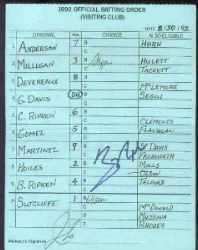A's (28) - 1993 Topps INAUGURAL ROCKIES - TEAM SET
LIMITED TO ONLY 5000 MADE !!! With MARK McGWIRE,Rickey Henderson,Dennis Eckersley,Ruben Sierra,Baines,Dave Stewart...
| Grade |
NM/MINT |
| Book Value |
n/a |
| Our Price |
$ 11.95
Add to cart
|


Below are short bits & pieces on sportscard & baseball trading card collecting.
Please wander around the website for more info, prices, values & images
on vintage baseball, football, basketball, hockey, sport and non-sports cards.

Authentic Major League SIGNED
Game-Used LINEUP Cards (PSA)

These are the official lineup cards SIGNED BY THE MANAGER & given
to the home plate umpire before the game with the team's line-up
& batting order !!! Making them even neater, often managers made
lineup changes on these cards throughout the game.
These official lineup cards were SIGNED BY THE MANAGER and presented
to the home plate umpire before the game. They detailed the team's lineup and
batting order. Managers often made lineup changes on these cards throughout
the game, making them even more unique.
Collectors say "They are official documents of a particular game, so they are
absolutely historically relevant. The manager, he was the general in the war.
Imagine owning Eisenhower's list of who he wanted to go into battle, and then he
signed it !!! Imagine what that would be worth?"
The first dugout lineup cards were seen around 1960. Along with lineup
cards, most ended up in the trash after games, making them quite rare today.
MLB saw the light and started marketing them directly in the 2000's.
Astronomical prices have been paid for cards from special games.
$165,010 for the Red Sox dugout lineup card from Game 4 of the 2004 World Series.
$138,000 in 2007 for 1st ever All-Star Game batting order cards.
$ 40,000 for batting order cards and the pen used to fill them out from
Cal Ripken's 2,130th & 2,131st games.
Click for complete
Major League SIGNED Game-Used LINEUP cards
Note: You may be on that page right now.
|

1969 Topps Team Posters
Checklist & Values
The 1969 Topps Team Posters set was made up of 24 large
11 1/4" x 19 3/4" colorful posters, 1 for each team.
The posters, the largest printed item by Topps to date,
were very colorful picturing 9 or 10 players with their facsimile autographs.
The Posters were sold one per pack at .10 cents each.
Because they were folded many times and usually placed on walls
with tape or pins, high grade posters are very scarce.
Click for complete
1969 Topps Baseball Team Posters checklist, values and prices.
Note: You may be on that page right now.
|

Baseball card collecting terms (part H-R)
High Numbers - vintage cards were issued in the ‘50s-‘70s in a series. During the
baseball season, the largest number of cards were made. As the schedule
progressed into September, when there would be less interest in baseball cards
, Topps for one, specifically decreased production and hence much less product
was available. As a result, a scarcity-factor was created and a premium holds
for these first type of "short-printed" cards.
Inserts - special randomly-inserted cards which are not part of the regular set.
Many modern inserts are sequentially-numbered and rarer than the card sets into which they are inserted.
O-Pee-Chee / OPC - a subsidiary of Topps, this card issue was produced specifically for distribution
in Canada.
Promotional Card - generally referred to as cards issued to show what the product
will look like on release and intended to help spur future sales. Often called
a "promo" card.
Reprint - cards issued to reproduce the originals. With the current trend of
vintage reprints, the new versions have a distinguishing characteristic
evidenced by numbering.
Restored - a card or piece of memorabilia which someone has tried to return to a
"like-new" condition. A restored card is considered to be of very little
value.
Rookie Card - any league-licensed, widely distributed card to feature a player in
his first year of trading cards.





 These are the official lineup cards SIGNED BY THE MANAGER & given
to the home plate umpire before the game with the team's line-up
& batting order !!! Making them even neater, often managers made
lineup changes on these cards throughout the game.
These official lineup cards were SIGNED BY THE MANAGER and presented
to the home plate umpire before the game. They detailed the team's lineup and
batting order. Managers often made lineup changes on these cards throughout
the game, making them even more unique.
These are the official lineup cards SIGNED BY THE MANAGER & given
to the home plate umpire before the game with the team's line-up
& batting order !!! Making them even neater, often managers made
lineup changes on these cards throughout the game.
These official lineup cards were SIGNED BY THE MANAGER and presented
to the home plate umpire before the game. They detailed the team's lineup and
batting order. Managers often made lineup changes on these cards throughout
the game, making them even more unique.
